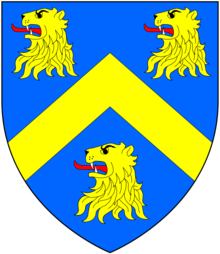
Back William Wyndham, 3. Baronet German William Wyndham Esperanto William Wyndham French William Wyndham Italian ウィリアム・ウィンダム (第3代準男爵) Japanese William Wyndham Polish William Wyndham Swedish
Sir William Wyndham | |
|---|---|
 Sir William Wyndham, 1713 portrait by Jonathon Richardson, National Portrait Gallery, London | |
| Chancellor of the Exchequer | |
| In office 1713–1714 | |
| Preceded by | Sir Robert Benson |
| Succeeded by | Sir Richard Onslow |
| Secretary at War | |
| In office 1712–1713 | |
| Preceded by | George Granville |
| Succeeded by | Francis Gwyn |
| Personal details | |
| Born | 1688 |
| Died | 17 June 1740 (aged 51–52) |
| Spouse(s) | Lady Catherine Seymour Maria Catherina de Jonge |
| Children | 5 |
| Parent(s) | Sir Edward Wyndham, 2nd Baronet Katherine Leveson-Gower |
| Education | Eton College |
| Alma mater | Christ Church, Oxford |


Sir William Wyndham, 3rd Baronet (c. 1688 – 17 June 1740),[1] of Orchard Wyndham in Somerset, was an English Tory politician who sat in the House of Commons from 1710 to 1740. He served as Secretary at War in 1712 and Chancellor of the Exchequer in 1713 during the reign of the last Stuart monarch, Queen Anne (1702–1714). He was a Jacobite leader firmly opposed to the Hanoverian succession and was leader of the Tory opposition in the House of Commons during the reign of King George I (1714–1727) and during the early years of King George II (1727–1760).
His first wife was Lady Catherine Seymour, the younger of the two daughters of Charles Seymour, 6th Duke of Somerset (died 1748), and in her children by Wyndham, heiress to half of the vast estates, including Petworth House in Sussex and Egremont Castle in Cumberland, formerly held by the extinct Percy family, Earls of Northumberland. As a result of this complex inheritance his eldest son became the 2nd Earl of Egremont. Both his sons became earls and his daughter Elizabeth Wyndham was both the wife and mother of Prime Ministers, namely George Grenville and William Wyndham Grenville respectively.
He built the pier at Watchet harbour, near Orchard Wyndham.[2]